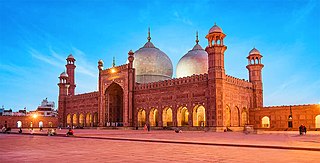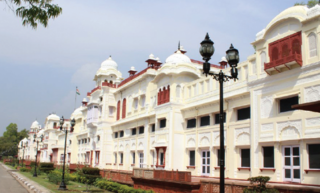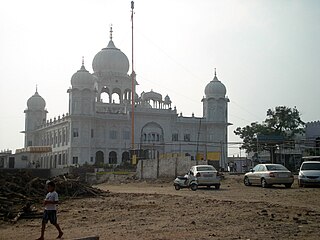Related Research Articles

Punjab is a province of Pakistan. With a population of over 127 million, it is the most populous province in Pakistan and second most populous subnational polity in the world. Located in the central-eastern region of the country, it has the largest economy, contributing the most to national GDP, in Pakistan. Lahore is the capital and largest city. Other major cities include Faisalabad, Rawalpindi, Gujranwala and Multan.

Lahore is the capital and largest city of the Pakistani province of Punjab. It is the second largest city in Pakistan, after Karachi, and 27th largest in the world, with a population of over 14 million. Lahore is one of Pakistan's major industrial, educational and economic hubs. It has been the historic capital and cultural center of the wider Punjab region, and is one of Pakistan's most socially liberal, progressive, and cosmopolitan cities.

Patiala is a city in southeastern Punjab, northwestern India. It is the fourth largest city in the state and is the administrative capital of Patiala district. Patiala is located around the Qila Mubarak constructed by a chieftain Ala Singh, who founded the royal dynasty of Patiala State in 1763, and after whom the city is named.

Ludhiana is the most populous city in the Indian state of Punjab. The city has an estimated population of 1,618,879 as of the 2011 census and distributed over 310 km2 (120 sq mi), making Ludhiana the most densely populated urban centre in the state. It is a major industrial center of Northern India, referred to as "India's Manchester" by the BBC. It is also known as the commercial capital of Punjab.

Punjab and Haryana High Court is the common High Court for the Indian states of Punjab and Haryana and the Union Territory of Chandigarh based in Chandigarh, India. Sanctioned strength of Judges of this High Court is 85 consisting of 64 Permanent Judges and 21 Additional Judges including Chief Justice. As of 14 September 2023, there are 58 Judges working in the High Court, comprising 36 Permanent and 22 Additional Judges.

Najafgarh is a town in the South West Delhi district of National Capital Territory of Delhi, India. It is one of the three subdivisions of the Southwest Delhi district. Najafgarh is located on outskirts of NCT Delhi in south western part of Delhi sharing its territory limits with Gurgaon and Bahadurgarh, in Haryana.

Jalandhar district is a district in Doaba region of the state of Punjab, India. The district headquarters is the city of Jalandhar.

Ludhiana district is one of the 23 districts in the Indian state of Punjab. It is Punjab's largest district by both area and population. Ludhiana, the largest city in Punjab, is the district headquarters.

Nada Sahib is a Sikh gurudwara in the Panchkula district of the Indian state of Haryana. Situated on the banks of the Ghaggar-Hakra River in the Sivalik Hills of Panchkula, it is the site where Guru Gobind Singh Ji halted while travelling from Paonta Sahib to Anandpur Sahib after the Battle of Bhangani in 1688.

Chitkara University is a private university located in Rajpura, Punjab, India. It offers undergraduate programs, post-graduate program and doctoral programs in fields of engineering, management, pharmacy, health sciences, nursing, hospitality, art & design and education. It was established and is managed by the Chitkara Educational Trust.

Punjab is a state in northwestern India. Forming part of the larger Punjab region of the Indian subcontinent, the state is bordered by the Indian states of Himachal Pradesh to the north and northeast, Haryana to the south and southeast, and Rajasthan to the southwest; by the Indian union territories of Jammu and Kashmir to the north and Chandigarh to the east. To the west, it shares an international border with the identically named Pakistani province of Punjab, and as such is sometimes referred to as East Punjab or Indian Punjab for disambiguation purposes. The state covers an area of 50,362 square kilometres, which is 1.53% of India's total geographical area, making it the 19th-largest Indian state by area out of 28 Indian states. With over 27 million inhabitants, Punjab is the 16th-largest Indian state by population, comprising 23 districts. Punjabi, written in the Gurmukhi script, is the most widely spoken and the official language of the state. The main ethnic group are the Punjabis, with Sikhs (57.7%) and Hindus (38.5%) forming the dominant religious groups. The state capital, Chandigarh, is a union territory and also the capital of the neighbouring state of Haryana. Three tributaries of the Indus River — the Sutlej, Beas, and Ravi — flow through Punjab.
Payal Fort is a Historic Monument of Punjab, built by Maharaja Amar Singh of Patiala Ryasat in Payal with the co-operation of the Mughals in 1771.

Serai Nurmahal is an inn of historical importance located at Nurmahal, near Jalandhar.

Mughal Serai, Doraha is a Caravanserai located at Doraha in Ludhiana District. Its popularly known as 'Mughal Caravan Serai' as well as Doraha Sarai. This is often confused with this place as Serai Lashkari Khan. Serai Lashkari Khan is situated at 8-9 km distance from this.

Serai Lashkari Khan located near Gurdwara Manji Sahib, Kotan in Ludhiana District, Punjab, India is a historical inn built by Mughal military general Lashkari Khan, in the reign of Emperor Aurangzeb in 1667 CE.

The Fateh Burj, a prominent tourist site in Punjab and the tallest victory tower in India, is situated in the historical village of Chappar Chiri in the SAS Nagar district of Punjab state. It was completed in 2011. The 328-foot (100 m) tower is dedicated to establishment of the Sikh Misls in a large part of Punjab in 1711. It is situated in Banda Singh Bahadur Road. It is situated just outside Mohali, 140 kilometres from Amritsar and 20 km from Sirhind. It was here that Banda Singh Bahadur, one of the most respected and great Sikh warriors, won a decisive battle against Wazir Khan, commander of the Mughal army.
Rupnagar Assembly constituency is a Punjab Legislative Assembly constituency in Rupnagar district, Punjab state, India.
Kharar Assembly constituency is a Punjab Legislative Assembly constituency in Kharar Sahibzada Ajit Singh Nagar district, Punjab state, India. Anmol Gagan Maan of the Aam Aadmi Party is the incumbent MLA.
S.A.S. Nagar Assembly constituency is one of the 117 Legislative Assembly constituencies of Punjab state in India. It is part of Mohali district.
Shambhu is a village in the Patiala district, Punjab, India, near its border with Haryana. The village has a Khurd and Kalan set-up. Shambhu Kalan is also the headquarters of an eponymous community development block with 83 villages.
References
- ↑ Parihar, Subhash (1993). "Mughal Sarai at Shambhu". Islamic Studies. 32 (4): 433–446. ISSN 0578-8072.
- ↑ "Archived copy" (PDF). Archived from the original (PDF) on 20 September 2010. Retrieved 24 March 2010.
{{cite web}}: CS1 maint: archived copy as title (link) - ↑ "Bassi Pathana". Archived from the original on 12 October 2017. Retrieved 24 March 2010.
- ↑ "Govt to develop three Mughal serais as wedding destinations". The Tribune India. Retrieved 27 December 2018.
- ↑ "Mughal Serai, Shambhu | Mughal Architecture |". nripunjab.gov.in. Retrieved 27 December 2018.